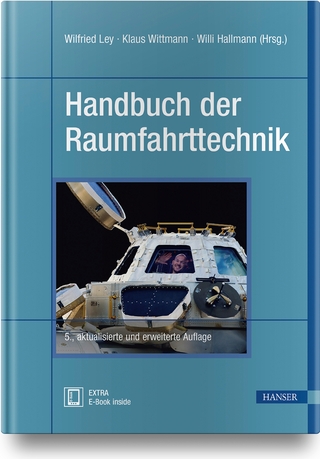
Computational Space Flight Mechanics
Seiten
2014
|
2010
Springer Berlin (Verlag)
978-3-642-43211-8 (ISBN)
Springer Berlin (Verlag)
978-3-642-43211-8 (ISBN)
Computational Space Flight Mechanics presents numerical solutions for topics and problems within space flight mechanics. Topics include orbit determination, Lagrange's perturbation equations for disturbed Earth's orbits, the flight of a mass point in flight path coordinates, and more.
Themechanicsofspace?ightisan olddiscipline.Itstopicoriginallywasthemotion of planets, moons and other celestial bodies in gravitational ?elds. Kepler's (1571 - 1630) observations and measurements have led to probably the ?rst mathematical description of planet's motion. Newton (1642 - 1727) gave then, with the devel- ment of his principles of mechanics, the physical explanation of these motions. Since then man has started in the second half of the 20th centuryto capture ph- ically the Space in the sense that he did develop arti?cial celestial bodies, which he brought into Earth's orbits, like satellites or space stations, or which he did send to planets or moons of our planetary system, like probes, or by which p- ple were brought to the moon and back, like capsules. Further he developed an advanced space transportation system, the U.S. Space Shuttle Orbiter, which is the only winged space vehicle ever in operation. In the last two and a half decades there were several activities in the world in order to succeed the U.S. Orbiter, like the HERMES project in Europe, the HOPE project in Japan, the X-33, X-34 and X-37 studies and demonstrators in the United States and the joint U.S. - European project X-38. However, all these projects were cancelled. The motion of these vehicles can be described by Newton's equation of motion.
Themechanicsofspace?ightisan olddiscipline.Itstopicoriginallywasthemotion of planets, moons and other celestial bodies in gravitational ?elds. Kepler's (1571 - 1630) observations and measurements have led to probably the ?rst mathematical description of planet's motion. Newton (1642 - 1727) gave then, with the devel- ment of his principles of mechanics, the physical explanation of these motions. Since then man has started in the second half of the 20th centuryto capture ph- ically the Space in the sense that he did develop arti?cial celestial bodies, which he brought into Earth's orbits, like satellites or space stations, or which he did send to planets or moons of our planetary system, like probes, or by which p- ple were brought to the moon and back, like capsules. Further he developed an advanced space transportation system, the U.S. Space Shuttle Orbiter, which is the only winged space vehicle ever in operation. In the last two and a half decades there were several activities in the world in order to succeed the U.S. Orbiter, like the HERMES project in Europe, the HOPE project in Japan, the X-33, X-34 and X-37 studies and demonstrators in the United States and the joint U.S. - European project X-38. However, all these projects were cancelled. The motion of these vehicles can be described by Newton's equation of motion.
Coordinate Transformations.- Transformations between Often Used Coordinate Systems.- Kepler's Laws of Planetary Motion and Newton's Celestial Mechanics.- The Two-Body Problem.- General Equations for Planetary Flight.- A Resumé of the Aerothermodynamics of Space Flight Vehicles.- Three and Six Degree of Freedom Trajectory Simulations.- Numerical Applications of the General Equations for Planetary Flight.- The Earth Atmosphere.- Solution of Problems.- Our Planetary System.- FORTRAN Codes.- MATLAB Codes.- Constants, Relations, Units and Conversions.
| Erscheint lt. Verlag | 23.11.2014 |
|---|---|
| Zusatzinfo | XIV, 300 p. |
| Verlagsort | Berlin |
| Sprache | englisch |
| Maße | 155 x 235 mm |
| Gewicht | 486 g |
| Themenwelt | Technik ► Luft- / Raumfahrttechnik |
| Schlagworte | Athmospheric Re-entry • Celestial mechanics • Consitent derivation of Governing Equations • FORTRAN • Kepler s Laws of Planetary Motion • Kepler´s Laws of Planetary Motion • MATLAB • Orbital mechancis • Planetary Flight • Simulation • Space Flight Mechanics |
| ISBN-10 | 3-642-43211-5 / 3642432115 |
| ISBN-13 | 978-3-642-43211-8 / 9783642432118 |
| Zustand | Neuware |
| Haben Sie eine Frage zum Produkt? |
Mehr entdecken
aus dem Bereich
aus dem Bereich
Grundlagen, Mathematik, Kartenkunde, leistungsbasierte Navigation
Buch | Softcover (2022)
De Gruyter Oldenbourg (Verlag)
72,95 €
Das aktuelle Raumfahrt-Jahrbuch mit allen Starts
Buch | Softcover (2022)
Verein zur Förderung der Raumfahrt e.V. (Verlag)
18,90 €


